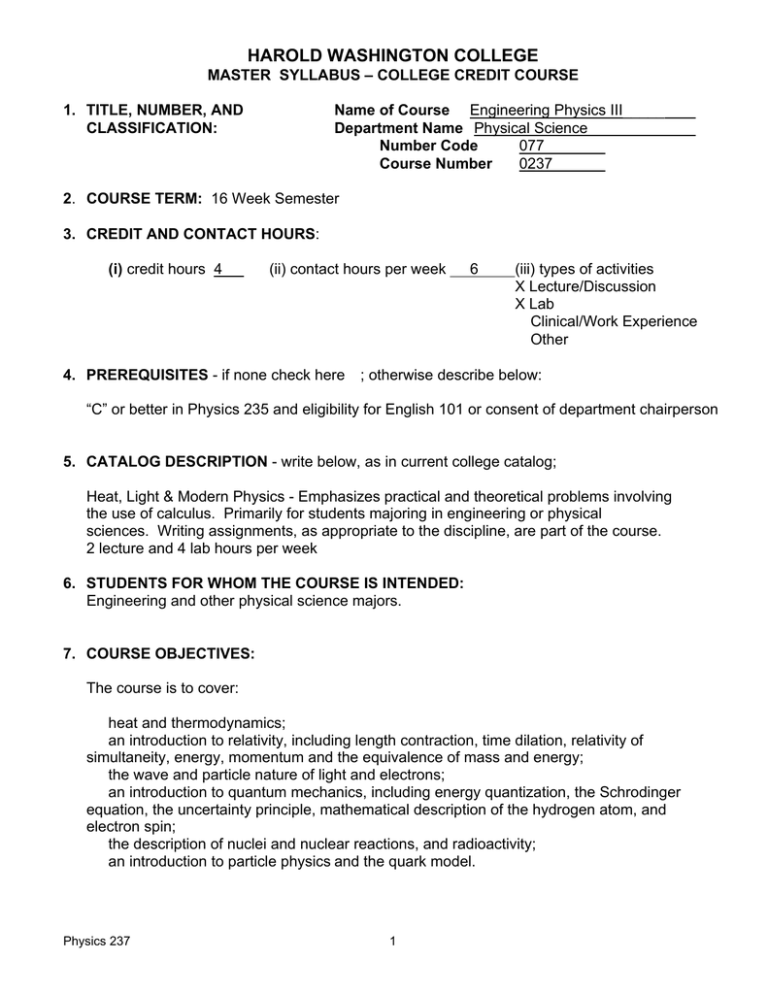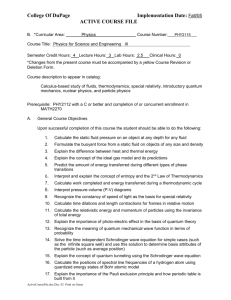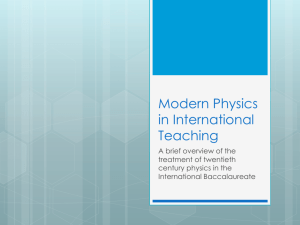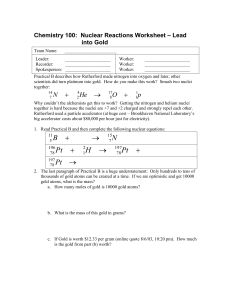
HAROLD WASHINGTON COLLEGE
MASTER SYLLABUS – COLLEGE CREDIT COURSE
1. TITLE, NUMBER, AND
CLASSIFICATION:
Name of Course Engineering Physics III_____
Department Name Physical Science
Number Code
077
Course Number
0237
2. COURSE TERM: 16 Week Semester
3. CREDIT AND CONTACT HOURS:
(i) credit hours 4
(ii) contact hours per week
4. PREREQUISITES - if none check here
6
(iii) types of activities
X Lecture/Discussion
X Lab
Clinical/Work Experience
Other
; otherwise describe below:
“C” or better in Physics 235 and eligibility for English 101 or consent of department chairperson
5. CATALOG DESCRIPTION - write below, as in current college catalog;
Heat, Light & Modern Physics - Emphasizes practical and theoretical problems involving
the use of calculus. Primarily for students majoring in engineering or physical
sciences. Writing assignments, as appropriate to the discipline, are part of the course.
2 lecture and 4 lab hours per week
6. STUDENTS FOR WHOM THE COURSE IS INTENDED:
Engineering and other physical science majors.
7. COURSE OBJECTIVES:
The course is to cover:
heat and thermodynamics;
an introduction to relativity, including length contraction, time dilation, relativity of
simultaneity, energy, momentum and the equivalence of mass and energy;
the wave and particle nature of light and electrons;
an introduction to quantum mechanics, including energy quantization, the Schrodinger
equation, the uncertainty principle, mathematical description of the hydrogen atom, and
electron spin;
the description of nuclei and nuclear reactions, and radioactivity;
an introduction to particle physics and the quark model.
Physics 237
1
8. STUDENT LEARNING OUTCOMES
By means of written responses, drawing diagrams, and solving problems involving
calculation, the student will demonstrate the ability to
draw and interpret a phase diagram for a pure substance; use the ideal gas law in problems
relating temperature, pressure, volume and mass of an ideal gas; describe adiabatic,
isothermal, isobaric and isochoric processes, and use these concepts in conjunction with the
ideal gas law in problem solving;
relate thermal energy changes to the specific heat of a substance; use specific heats and
latent heats of fusion and vaporization with the concept of thermal equilibrium to solve
calorimetry problems;
relate the temperature of an ideal gas to the average kinetic energy of its molecules; relate
the number of degrees of freedom of diatomic and polyatomic gases to their specific heats;
use the first law of thermodynamics to relate work, heat, and internal energy changes of a
system such as an ideal gas;
describe cavity radiation in terms of standing waves; use the laws of Kirchhoff, Wien and
Stefan-Boltzmann to relate temperature of a cavity, energy density, intensity and wavelength of
emitted electromagnetic waves;
draw and interpret a rough graph of Planck’s curve for cavity radiation; relate photon energy
and wavelength using Planck’s constant; relate photon energy to the minimum x-ray
wavelength emitted by a metal bombarded with electrons;
state the principle of relativity; use calculations of length contraction, time dilation and
relativity of simultaneity according to the theory of special relativity; use the Lorentz
transformations to relate event coordinates in different frames of reference;
use the relativistic formula for addition of velocities, and for the Doppler effect on light;
analyze collisions of subatomic particles using relativistic principles of conservation of energy
and momentum;
analyze scattering of x-rays according to the Compton effect, using the photon concept;
analyze examples of the photoelectric effect using the photon concept;
use the concept of matter waves and the relation between particle momentum and
wavelength to analyze propagation and reflection from crystals of electrons and other particles;
analyze descriptions of measurements using the limitations imposed by the Heisenberg
uncertainty principle;
relate energy levels, conservation of energy and the photon concept to the emission and
absorption of light by hydrogen atoms, and in less detail by other atoms and molecules;
solve the Schrodinger equation for infinite potential wells in one, two and three dimensions,
and interpret the solutions in terms of probability density; use the hydrogen atom wave
functions to calculate probabilities of finding electrons in specified regions;
Physics 237
2
describe the filling of positions in the periodic table using the concepts of quantum numbers
for energy and angular momentum, including electron spin, and the Pauli exclusion principle;
describe the strong nuclear force that binds nuclei, the effect of proton-proton repulsion, and
the role neutrons play in stabilizing nuclei; relate binding energy to nuclear stability and mass
defect;
describe the principle types of radioactive decay, including emitted particles and changes in
the emitting nuclei; relate nuclear half life to decay rates and to initial and final numbers of
radioactive nuclei; describe radioactive decay series;
describe nuclear fission, and the types of nuclei likely to fission; describe how nuclear
fission is used in nuclear power plants to generate energy; describe nuclear fusion and the
types of nuclei that are likely to fuse; describe the release of energy by nuclear fusion in the
sun, and the reason high temperatures are required;
describe the three classes of subatomic particles: baryons, mesons, and leptons;
distinguish fermions and bosons in terms of the Pauli exclusion principle;
describe the quark model of subatomic particles, including the quark composition of protons
and neutrons; distinguish baryons and mesons in terms of the quark model; describe the role
of color charge and gluons in the quark model; describe the three families of subatomic
particles based on the quark model; describe the various conservation laws that limit the types
of subatomic particles that can be produced in particle colliders.
9.
TOPICAL COURSE OUTLINE:
Heat and Thermodynamics:
Heat capacities, heat transfer, latent heat,
Equilibrium and temperature “0th law of thermodynamics”;
Gas laws, kinetic theory of ideal gas, equipartition;
1st law of thermodynamics;
Maxwell-Boltzmann distributions, Averages for ideal gas.
Light:
Thermodynamics of enclosed electromagnetic radiation, counting modes;
Kirchhoff’s law for thermodynamic equilibrium of radiation;
Stefan-Boltzmann law, energy density, Wien’s law;
Planck curves and Planck’s constant; X-Rays.
Relativity:
The principle of relativity;
Relativistic kinematics, including the Lorentz transformation, velocity addition, and the
Doppler effect for light;
Relativistic dynamics, emphasizing energy and momentum conservation;
Quantum Mechanics:
Quantization of light, including the photoelectric effect and the Compton
effect;
Physics 237
3
Quantization of energy, emphasizing the hydrogen atom;
Matter waves and the Heisenberg uncertainty relations;
The Schrodinger equation in one dimension and the particle in a box;
The Schrodinger equation in 3 dimensions, the 3 dimensional box;
The hydrogen atom, angular momentum, electron spin;
Quantum numbers and the periodic table.
Nuclei:
Properties of nuclei, nuclear force, exclusion of electrons from nuclei;
Effect of coulomb repulsion on protons;
Semi-empirical mass formula, binding energy curve.
Radioactivity and Nuclear Reactions: Alpha, beta and gamma decay;
Exponential decay law, lifetime and half-life;
Radioactive series, fission, fusion.
Particle Physics:
History of particle discoveries and predictions; different interactions;
Particle classification and conservation laws;
Quark Model, Electroweak Theory, Quantum Chromodynamics (Standard Model)
Visit to Fermilab Collider (optional)
Students will be required to demonstrate laboratory skills in a series of experiments by:
Measuring quantities carefully and correctly, including units and uncertainties;
Making calculations from data correctly, including uncertainties in results where
required;
Recording data and calculations in a clear and organized way, with notes that make
their meanings clear;
Carefully and correctly plotting required graphs, and obtaining quantitative results
from them;
Organizing data, calculations, graphs, results and additional written work to clarify
them into a clear and literate report on the experiment.
10. TEXTS AND MATERIALS USED: List of books and/or materials suggested for this course:
Knight, R. D., Physics for Scientists and Engineers with Modern Physics, vols. 2 and 5,
Pearson/Addison Wesley, 2004
Physics 237 Laboratory Manual, written by the instructor and handed out in class
11. AMOUNT OF WRITING REQUIRED:
Ten reports on experiments, approximately three pages each
12. METHODS OF EVALUATION: (Direct and indirect)
Four examinations (75%), ten quizzes (10%), ten reports on experiments (15%)
13. AUTHORIZED SIGNATURE AND FILE DATE:
DEPARTMENT AND CAMPUS
5/06
Physics 237
4
Physical Science Department
Harold Washington College






